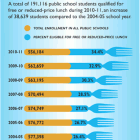Disparities
Reforms Planned To Reduce Restraints, Seclusion In Schools
|
Legislative changes and increased training of school staff could help to reduce the incidence of children being restrained and secluded in schools, a panel of state officials said Friday at a forum hosted by U.S. Sen. Chris Murphy, D-Conn. The roundtable discussion was organized in response to a February report by the state Office of the Child Advocate (OCA) that raised “significant concern” about the frequency with which young children with autism and other disabilities are restrained or secluded in Connecticut schools. In each of the last three years, the state Department of Education has reported about 30,000 incidents of restraints or seclusion, with autistic students the most frequently subjected to the practices. More than 1,300 children have been injured while restrained or isolated. Research has shown that the techniques can be traumatizing to children, with no evidence that they have therapeutic value, the OCA report says.



